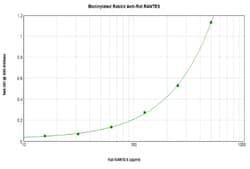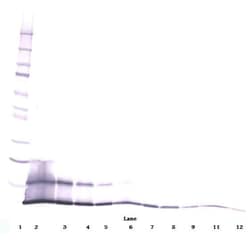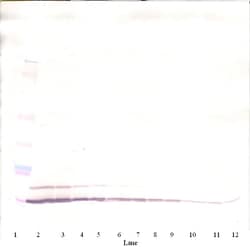Learn More
CCL5 (RANTES) Polyclonal Antibody, Biotin, PeproTech®, Invitrogen™ 
Rabbit Polyclonal Antibody
$337.00 - $432.00
Specifications
| Antigen | CCL5 (RANTES) |
|---|---|
| Concentration | 0.1-1.0 mg/mL |
| Applications | ELISA, Western Blot |
| Classification | Polyclonal |
| Conjugate | Biotin |
| Catalog Number | Mfr. No. | Quantity | Price | Quantity | |||||
|---|---|---|---|---|---|---|---|---|---|
| Catalog Number | Mfr. No. | Quantity | Price | Quantity | |||||
500P78BT25

|
Invitrogen™
500P78BT25UG |
25 μg |
Each for $337.00
|
|
|||||
500P78BT50

|
Invitrogen™
500P78BT50UG |
50 μg |
Each for $432.00
|
|
|||||
|
50-271-8449
|
Invitrogen™
500P78BT500UG |
500 μg |
N/A
|
N/A | |||||
| Please call Customer Service at 1-800-234-7437 or send an email to help@thermofisher.com for assistance. | |||||||||
Description
AA Sequence of recombinant protein: SPYGSDTTPC CFAYLSLALP RAHVKEYFYT SSKCSNLAVV FVTRRNRQVC ANPEKKWVQE YINYLEMS. Preparation: Produced from sera of rabbits immunized with highly pure Recombinant Rat RANTES (CCL5). Anti-Rat RANTES (CCL5)-specific antibody was purified by affinity chromatography and then biotinylated. Sandwich ELISA: To detect Rat RANTES by sandwich ELISA (using 100 μL/well antibody solution) a concentration of 0.25-1.0 μg/mL of this antibody is required. This biotinylated polyclonal antibody, in conjunction with PeproTech Polyclonal Anti-Rat RANTES (500-P78) as a capture antibody, allows the detection of at least 0.2-0.4 ng/well of Recombinant Rat RANTES. Western Blot: To detect Rat RANTES by Western Blot analysis this antibody can be used at a concentration of 0.1-0.2 μg/mL. Used in conjunction with compatible secondary reagents the detection limit for Recombinant Rat RANTES is 1.5-3.0 ng/lane, under either reducing or non-reducing conditions. 500-P78BT-1MG will be provided as 2 x 500 μg
CCL5 (RANTES) is a chemokine gene located on the q-arm of chromosome 17. Chemokines are a superfamily of secreted proteins involved in immunoregulatory and inflammatory processes. The superfamily is divided into four subfamilies based on the arrangement of the N-terminal cysteine residues of the mature peptide. CCL5, a member of the CC subfamily, functions as a chemoattractant for blood monocytes, memory T helper cells, and eosinophils. It causes the release of histamine from basophils and activates eosinophils. This cytokine is one of the major HIV-suppressive factors produced by CD8+ cells. It functions as one of the natural ligands for the chemokine receptor chemokine (C-C motif) receptor 5 (CCR5), and it suppresses in vitro replication of the R5 strains of HIV-1, which use CCR5 as a coreceptor. Alternative splicing results in multiple transcript variants that encode different isoforms. Diseases associated with CCL5 include Human Immunodeficiency Virus Type 1 and Periapical Granuloma.Specifications
| CCL5 (RANTES) | |
| ELISA, Western Blot | |
| Biotin | |
| Rabbit | |
| Rat | |
| P50231 | |
| 81780 | |
| E.coli-derived, 7.9 kDa Recombinant Rat RANTES (CCL5). | |
| Antigen Affinity Chromatography | |
| CCL5 |
| 0.1-1.0 mg/mL | |
| Polyclonal | |
| Lyophilized | |
| RUO | |
| PBS with no preservative | |
| beta-chemokine RANTES; CC chemokine; C-C motif chemokine 5; C-C motif chemokine ligand 5; CCL5; chemokine (C-C motif) ligand 5; D17S136E; EoCP; eosinophil chemotactic cytokine; MGC17164; MuRantes; OTTHUMP00000197106; RANTES; RANTES protein; RANTES(3-68); RANTES(4-68); regulated upon activation normal T-cell expressed and secreted; regulated upon activation, normally T-expressed, and presumably secreted; Scya5; SIS d; SISd; SIS-delta; SISd; small inducible cytokine A5; small inducible cytokine subfamily A (Cys-Cys), member 5; small-inducible cytokine A5; T cell-specific protein P228; T-cell specific protein p288; T-cell-specific protein RANTES; TCP228; Unknown (protein for MGC:127014) | |
| CCL5 | |
| Primary | |
| -20°C |


